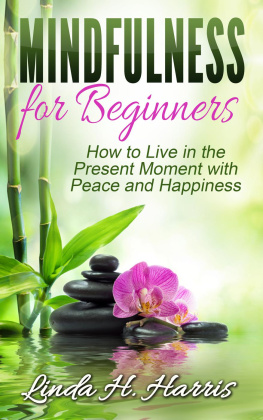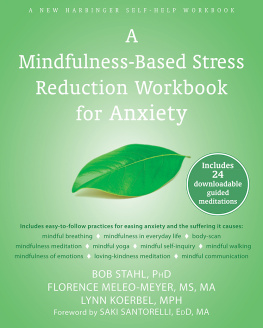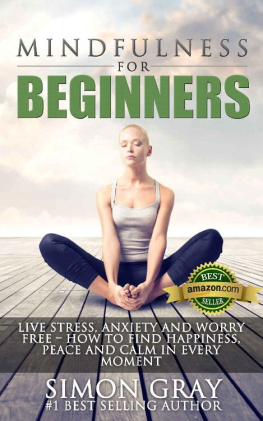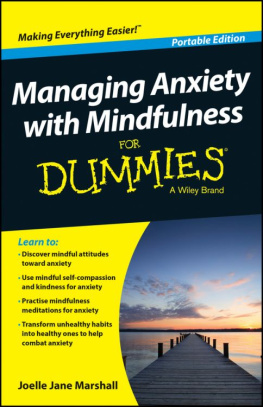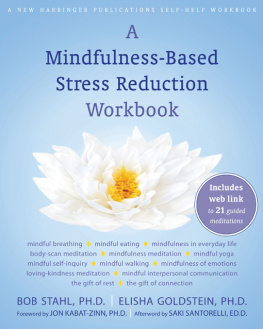References
Armour, J. A., and J. Ardell, eds. 1994. Neurocardiology. New York: Oxford University Press.
Astin, J. A. 1997. Stress reduction through mindfulness meditation: Effects on psychological symptomatology, sense of control, and spiritual experiences. Psychotherapy and Psychosomatics 66(2):97-106.
Boorstein, S. 2006. Road Sage: Mindfulness Techniques for Drivers. Audio CD. Louisville, CO: Sounds True.
Brown, K. W., and R. M. Ryan. 2003. The benefits of being present: Mindfulness and its role in psychological well-being. Psychological Science 84(4):822-848.
Cannon, W. A. 1915. Bodily Changes in Pain, Hunger, Fear and Rage: An Account of Recent Researches into the Function of Emotional Excitement. New York: Appleton.
DeMello, T. 1990. Awareness. New York: Doubleday.
DuPont, L. H. 2001. Footprints in the Snow. Boston: Journey Editions.
Kabat-Zinn, J., A. O. Massion, J. Kristeller, L. G. Peterson, K. E. Fletcher, L. Pbert, W. R. Lenderking, and S. F. Santorelli. 1992. Effectiveness of a meditation-based stress reduction program in the treatment of anxiety disorders. American Journal of Psychiatry 149(7):936-943.
Kabat-Zinn, J., E. Wheeler, T. Light, Z. Skillings, M. J. Scharf, T. G. Cropley, D. Hosmer, and J. D. Bernhard. 1998. Influence of a mindfulness meditation-based stress reduction intervention on rates of skin clearing in patients with moderate to severe psoriasis undergoing phototherapy (UVB) and photochemotherapy (PUVA). Psychosomatic Medicine 60(5):625-632.
Keating, T. 1996. Intimacy with God: An Introduction to Centering Prayer. New York: Crossroad Publishing.
Maslow, A. 1966. Psychology of Science: A Reconnaissance. New York: Harper Collins.
McCraty, R. 2003. The Appreciative Heart: The Psychophysiology of Positive Emotions and Optimum Functioning. Boulder Creek, CA: Institute of HeartMath.
Merton, T. 1972. New Seeds of Contemplation. New York: New Directions Books.
Nhat Hanh, T. 2001. Anger: Wisdom for Cooling the Flames. New York: Riverhead Books.
Page, C. 1992. Frontiers of Health: From Healing to Wholeness. Essex, UK W. Daniel Company.
Post, R. M., S. R. Weiss, H. Li. M. A. Smith, L. X. Zhang, G. Xing, E. A. Osuch, and U. D. McCann. 1998. Neural plasticity and emotional memory. Development and Psychopathology 10(4):829-855.
Rein, G., M. Atkinson, and R. McCraty. 1995. The physiological and psychological effects of compassion and anger. Journal of Advancement in Medicine 8(2):87-105.
Ruiz, D. M. 1997. The Four Agreements: A Practical Guide to Personal Freedom; A Toltec Wisdom Book. San Rafael, CA: Amber-Allen.
Shriver, M. 2009. Interview: Living with Alzheimers in the family. ABC News, Good Morning America. http://abcnews.go.com/GMA/OnCall/story?id=7525258. Accessed May 30, 2009.
Spiess, R. 2002. In Haiku Poetry: Ancient and Modern, ed. J. Hardy, p. 47. Boston: Turtle Publishing.


Publishers Note
This publication is designed to provide accurate and authoritative information in regard to the subject matter covered. It is sold with the understanding that the publisher is not engaged in rendering psychological, financial, legal, or other professional services. If expert assistance or counseling is needed, the services of a competent professional should be sought.
Distributed in Canada by Raincoast Books
Copyright 2009 by Thomas Roberts
New Harbinger Publications, Inc.
5674 Shattuck Avenue
Oakland, CA 94609
www.newharbinger.com
All Rights Reserved
Epub ISBN: 9781608826537
Acquired by Jess OBrien; Cover design by Amy Shoup;
Edited by Jasmine Star; Text design by Tracy Carlson
The Library of Congress has Cataloged the Print Edition as:
Roberts, Thomas B.
The mindfulness workbook : a beginners guide to overcoming fear and embracing compassion / Thomas Roberts.
p. cm.
Includes bibliographical references.
ISBN-13: 978-1-57224-675-1 (pbk. : alk. paper)
ISBN-10: 1-57224-675-8 (pbk. : alk. paper) 1. Mind and body. 2.
Fear. 3. Compassion. I. Title.
BF161.R658 2009
158.1--dc22
2009038436
Acknowledgments
So many peoples lives have crossed my path. Some have joined me, some have declined, some stayed awhile and left, and all have made a profound impact on my life and soul. Many teachers have brought me to this point in my life. Some of them are formal teachers, like Dr. William Easson, who captivated my interested in the workings of the human mind. Others taught in different ways, like my brother Bob, who taught me that there was meaning beyond the sounds of silence; my sister Pam, who responded so selflessly; my sister Pat, whose death when I was a young boy awakened my journey; and Steve, a young client I encountered early in my career, who taught me to be comfortable with the strange and unpredictable.
My children, too, have been teachers, sent to me from beyond: Laura Shawn, whose insistence on the musical and wondrous is an inspiration; and Karl, who taught me that nothing this life dishes out is any reason to quit or give up. Some of my children arrived in my life at a later point and already on their journey: Laura K, who taught me that the size of a person resides in their heart and enthusiasm; and Stephanie, who taught me that gentle and quiet are deep and strong places.
For unwavering loyalty and support, I thank my office manager, Kathy R., whose steady patience reminds me to keep from complicating things, and that simple is good, and also thank Simon. Teachers also appeared in the form of my mistakes, which were lifes corrective messages. I think I listened to most of them, and when I didnt, they kept coming back until I did.
Thank you to Jess OBrien and Jess Beebe at New Harbinger Publications for your patience, suggestions, and encouragement throughout this most challenging journey. Your ideas have made their mark on this book. A special thank you to Jasmine, copy editor extraordinaire. From beginning to end, your skill and grace are infused throughout this book. You helped me create a book that is both readable and useful.
Then there is Kathy, my love, my strength, my friend, my inspiration. Your patience, love, and acceptance of me have touched me deeply. Without you standing by and paying attention to everything, including all of the details of daily life, I could not have written this book. Your honesty about which parts of my manuscript had more or less merit allowed me the freedom and creativity to explore during the writing process without having to worry if I made sense. Now that I think about it, I guess this also applies to how you have handled me in general. We are truly on a journey together, and I cant wait for the next episode. With spacious love and gratitude I hold you in my heart always.
Introduction
Mindfulness is a way of being in the world. Being mindful means responding, not reacting, to the ever-present flow of events and experiences in your life with patience, openness, and compassion. Unfortunately, many of us have been conditioned to believe that we must protect ourselves from life and its experiences from a place of fear. This fear can harden you and influence the way you relate to yourself and your world, and ultimately create a great deal of suffering. Suffering doesnt lie in what occurs, it lies in resisting or fighting what occurs. But what if the true nature of the flow of your experiences is actually quite different from what you perceive and are reacting to? What if you could learn to observe the flow of your experiences without judgment, preconception, or distraction?


